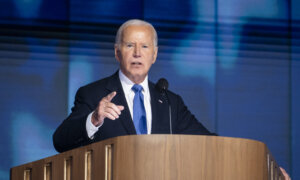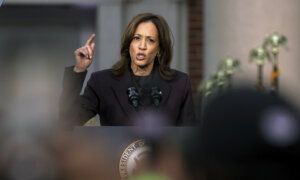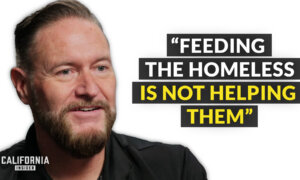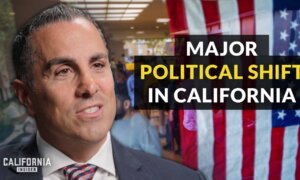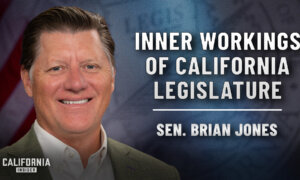President-elect Donald Trump won the 2024 election in part because working-class voters continued their migration toward the America First populism that Trump has advocated for the past three election cycles.
One indicator of that shift is the working-class city of Fall River, Massachusetts, which voted Republican for the first time in 100 years.
“Consider that from ’96 through the last Obama election, Democrats got 70 to 75 percent of the vote in Fall River. That’s an enormous swing,” author and political commentator E.J. Dionne said at a Nov. 12 panel discussion hosted by the Brookings Institution.
“And that does speak to the decline of the Democratic vote among non-college whites and others without a college degree.”
The shift is significant enough to be termed a global phenomenon, according to William Galston, a senior fellow at the Brookings Institution.
“We are witnessing the emergence of a new politics of class,” Galston said at the panel discussion. “Class, defined as educational attainment, dominates the scene in the United States and throughout the industrialized world.”
How America Voted
Here’s how the class divide looked in 2024 and what it means for the future of both parties.Analysts commonly use education and income levels as indicators of working-class identity.
Among those who never attended college, Trump won 63 percent of the vote, according to exit polling conducted by Edison Research for a consortium of news organizations.
Among those having some college education but not earning a degree, the number was 51 percent.
Trump did best among voters near the middle of the income scale.
Among those with an annual household income between $30,000 and $99,000, who accounted for nearly half of all voters, the majority voted for Trump.
The median household income in 2023 was $80,610, according to the U.S. Census Bureau.
Harris did best with voters from the top and bottom of the income scale.
The vice president won 50 percent of the votes from households earning below $30,000 per year. The federal poverty level for a family of four is $31,200 per year.
Harris won 51 percent among households earning $200,000 annually.
Households earning more than double the U.S. median are considered upper-income, according to Pew Research.
While the majority of all women, 53 percent, voted for Harris, that trend did not hold for all working women, according to Galston.
“White working-class women voted a lot more like white working-class men than they did women with college degrees,” Galston said. “It wasn’t even close.”
Reckoning for Democrats
Democrats lost the White House because they ignored the needs of working-class voters, according to Sen. Bernie Sanders (I-Vt.).“It should come as no great surprise that a Democratic Party which has abandoned working class people would find that the working class has abandoned them,” Sanders wrote on Nov. 6.
Jamie Harrison, chair of the Democratic National Committee, criticized Sanders’s remarks, saying, “Biden was the most pro-worker president of my lifetime.”
Others, including Sen. Chris Murphy (D-Conn.), agreed with Sanders that the Democratic Party had lost touch with the working class.
“We don’t listen enough; we tell people what’s good for them,” Murphy wrote, adding that the party should listen to poor and rural people and men in crisis.
“Real economic populism should be our tentpole.”
“The reason we didn’t win, ultimately, is we didn’t listen enough to people on the ground,” Rep. Ro Khanna (D-Calif.) said on “Face the Nation” on Nov. 10.
“People like Chris Deluzio, Pat Ryan, who were saying, ‘Talk about the economy, talk about people’s economic struggles, convince people you have the better policies and better vision.’”
Economic factors were the driving force behind this migration into the Republican coalition for at least one portion of the working class, according to Gabriel Sanchez, a professor of political science at the University of New Mexico.
“Overwhelmingly, the economy is what Latino men have actually been talking about for three election cycles in a row,” Sanchez said, noting that one in five Latino men work in the building industry.
Trump’s outreach to men in particular helped close the deal, according to Sanchez.
“Trump and Vance were communicating a much different message [than Harris] … that men, you belong here. We appreciate you and everything you bring to the table,” he said.
While Democrats spent much of their time campaigning against Trump’s character, voters had other concerns, according to Dionne.
“[We thought] Trump’s unpopularity and the danger he posed to the republic would move more voters than actually happened,” Dionne said. “It was a run-of-the-mill election because people were still deeply upset about the economy.”
Latino men, in particular, were willing to overlook Trump’s drawbacks because they trusted him to fix the economy, Sanchez said.
They told him, “I believe Trump will prioritize the economy over everything else because he did that during COVID,” he said.
Republican Opportunity, Not a Guarantee
While working-class voters helped put Trump on top in this election, experts say that should not be taken as a guarantee of future loyalty.One reason is that the victory is not as decisive as it may appear.
“I think it’s very important to underscore that when all the votes are counted, it could be a point or a point and a half victory in the popular vote,” Dionne said.
According to David Schultz, a professor of political science at Hamline University, the electoral victory hinged on a relatively small percentage of votes in swing states.
“A shift of 121,000 votes across Michigan, Pennsylvania, and Wisconsin would have produced a different result with Harris winning,” Schultz told The Epoch Times.
Also, Harris won the majority of union voters at 53 percent, a slight decrease from 2020 but an increase from 2016 for her party.
Although union members account for just 10 percent of the workforce, they were heavily courted by both Trump and Harris.
If Republicans can make good on their promise to improve the economy, their compact with the working class and with Latino voters in particular may go beyond one election, Sanchez said.




